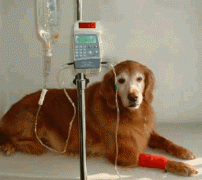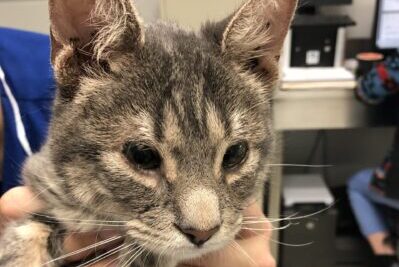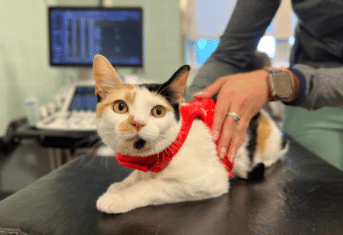Fluid Therapy

Fluid Therapy
If you visit a friend in the hospital, you are likely to notice their doctor is treating them with intravenous fluids. If you visit your pet in the veterinary hospital, you will notice the same may be true – clear fluid is dripping intravenously through a catheter.
Veterinarians and physicians use fluid therapy for exactly the same reasons: to treat dehydration, to increase low blood pressure, to replace fluids lost through vomiting and diarrhea or hemorrhage, and to provide fluids to animals during anesthesia or who may be unable to drink due to illness.
Fluid types
The major ingredient in intravenous fluids is water. But not water like what comes from the tap. First, intravenous fluids must be sterile. Fluid composition must also mimic the composition of blood with regard to the content of sodium, potassium, chloride and pH; if it does not, vital organs could be damaged by fluid therapy. Some fluids have extra components like calcium, magnesium, dextrose (sugar), and bicarbonate. The patient’s medical condition dictates which of the various preparations of intravenous fluids should be used.
Fluid administration
The fluid dripping from a plastic bag into your dog’s leg is being administered through the most common and direct route – intravenously. In emergency situations and when intravenous catheters cannot be easily placed, fluids can be administered into the hollow center of a leg or arm bone. Fluids may also be administered into the abdominal cavity, but fluid administered this way does not enter the blood vessels as rapidly, making it a less than ideal route of administration in emergency situations. Fluids given under the skin make home fluid therapy possible.
Fluids at home
Many cat owners manage the dehydration associated with chronic kidney disease by giving fluids at home. The same types of fluids we normally administer intravenously are given under the skin, more scientifically called subcutaneous fluids. Here is a video of administration of subcutaneous fluids in a cat.
Fluids can be given as often as once a day or less frequently to meet the cat’s fluid needs. The cat’s blood vessels slowly absorb the fluid from the subcutaneous space, providing additional fluid to help the ailing kidneys. Some dogs and cats with other diseases may be treated this way as well.
Fluids are not food
Many pet owners assume intravenous fluids provide nutrition. We can give nutrition intravenously but the fluid administered contains the building blocks of food – amino acids, lipids, and sugar. Administering nutrition intravenously is called parenteral nutrition and is reserved for patients with a non-functioning intestinal tract. Parenteral nutrition solution is milky white due to the lipids, not clear like fluids. Veterinarians do supplement intravenous fluids with intravenous sugar (glucose) for patients with low blood sugar from an insulin overdose or a serious infection resulting in low blood sugar.
If you have a sick pet, ask your veterinarian if subcutaneous fluids might be helpful as home care.


































